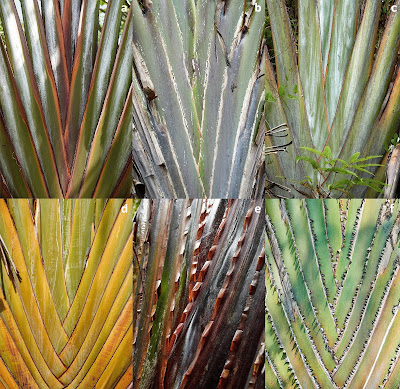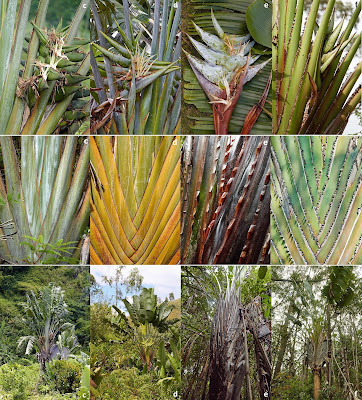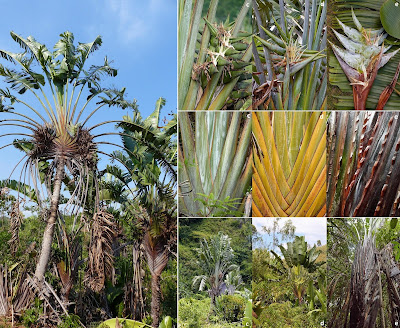Abstract
Madagascar’s emblematic traveller’s tree is a monospecific genus within Strelitziaceae, the family of the South African bird of paradise. Until now, this endemic genus consisted of a single species: Ravenala madagascariensis Sonn., which is grown everywhere in the tropics as an ornamental plant. The plant is immediately recognizable for its huge fan-forming banana-like leaves and is locally referred to in Magagascar by several vernacular names. “Variants” have been mentioned in the literature, but without any attempt to recognize formal taxa based on diagnostic features. In this paper, we formally describe five new species and fix the application of the name R. madagascariensis to the populations growing on the eastern coast of Madagascar, with the epitype growing in the marshy Fort-Dauphin area in the south. This paper has numerous implications for conservation biology and other domains of life sciences, due to the importance of this genus for the conservation of Madagascan ecosystems, the ornamental plant trade, as well as for its invasive status in several tropical areas.
 |
| Comparison of petiole bases. (a) Ravenala agatheae. (b) R. blancii. (c) R. grandis. (d) R. madagascariensis. (e) R. menahirana. (f) R. hladikorum. Photographs Thomas Haevermans ©. |
 |
| Comparison of inflorescences. (a) Ravenala agatheae. (b) R. blancii. (c) R. grandis. (d) R. madagascariensis. (e) R. menahirana. (f) R. hladikorum. Photographs Thomas Haevermans ©. |
 |
| Species of Ravenala in their natural habitat. (a) Ravenala agatheae. (b) R. blancii. (c) R. grandis. (d) R. madagascariensis. (e) R. menahirana. (f) R. hladikorum. Photographs Thomas Haevermans ©. |
Ravenala Adans.1 (1763: 67).
≡ Urania Schreb.22 (1789: 212).
–Ravenala Scop.23, nom. illeg. (1777: 96) as “Ravenalla Adans”.
Type species: Ravenala madagascariensis Sonn. [1782]
Ravenala madagascariensis Sonn. (1782: 2[ed. qto.]: 223, tt. 124–126).
Ecology Ravenala madagascariensis is a low-altitude species restricted to swampy areas of the eastern coast of Madagascar. Populations outside of Madagascar on nearby islands are reputedly non-indigenous.
Ravenala agatheae Haev. & Razanats. sp. nov.
Diagnosis Similar to Ravenala madagascariensis but differs in its dark green narrower laminae, tricolor petioles with very developed dryish petiole sheath margins, very waxy petioles, the persistence of older infructescences for several years, a purple stripe on the bract margin, longer bracts, a whitish perianth, brown blotches on its mature fused petals, the bracteole apex tinged with pink, an ovoid pointed stigma, dense infructescences, smaller inflorescences, the free petal much shorter than the fused petals, and an end of year flowering period.
Ecology This species is adapted to seasonally dry and warm coastal habitats, growing on slopes at low elevations in north-western coastal areas of Madagascar, from Antsiranana (Diego-Suarez) down to the Melaky region in the Mahajanga province.
Etymology This species is named after to the first author’s wife, Agathe Haevermans, a botanical illustrator at the Muséum National d’Histoire Naturelle, who helped discover this species in the field with the collecting team and who contributes greatly to botany by producing illustrations of new taxa from biodiversity hotspots such as Madagascar.

Ravenala blancii Haev., V. Jeannoda & A. Hladik sp. nov.
Diagnosis Similar to Ravenala madagascariensis but differs in its non-suckering habit, decurrent juvenile lamina bases, toroidal distribution of juvenile laminae, smaller number of leaves simultaneously alive on the adult plant, dark green lamina and green non waxy petiole, smaller leaves, smaller number of live inflorescences, smaller number of bracts in an inflorescence, non-waxy bracts, sub-simultaneous flowering, smaller flowers, smaller inflorescences, non-persistence of entire bracts on dry infructescences, October/November flowering period.
Ecology High-elevation species found in eastern rainforests at elevations between 600 and 1,100 m. The species seems to favor cool tropical humid and shady conditions.
Etymology This species is named after Dr. Patrick Blanc, world renowned botanist, plant ecologist and street artist, inventor of the planted vertical walls known as “Mur Végétal” and who first recognized the sheer originality of the juvenile phases of this peculiar taxon.
Ravenala grandis Haev., Razanats., A. Hladik & P. Blanc sp. nov.
Diagnosis Similar to Ravenala madagascariensis but differs in its non-suckering habit, much larger dimensions, very thick leathery laminae, very waxy dark green-yellowish petioles, much larger bracts and overall dimensions, whitish/pure white perianth, strong reddish-pink stripes on its bracteoles, cylindrical stigma without basal constriction, stamens much shorter than perianth, and fruit with a truncated apex.
Distribution Eastern rainforests at around 200–500 m elevation in Madagascar13,20.
Ecology This species seems to favor growing in low discontinuous forests on inselbergs12 and thrives in secondary degraded vegetation on the slopes of eastern rain forests.
Etymology The name of this species is in reference to its stature and habit, the most robust species of Ravenala known.
Ravenala hladikorum Haev., Razanats., V. Jeannoda & P. Blanc sp. nov.
Diagnosis Similar to Ravenala madagascariensis but differs in its non-suckering habit, the alternate positioning of its adult laminae, its dark green leaves, non-waxy petioles with their very papyraceous petiole sheath margins, more than 1 cm long, smaller lamina dimensions, smaller number of simultaneously live inflorescences, purple stripe on bracts and on bracteoles, non-waxy inflorescences, smaller inflorescences, dense infructescences, truncated fruit apices, and short flowering period from November to December.
Distribution Andasibe, Mantady, Ranomafana. Restricted to Madagascar.
Ecology High-elevation species found in eastern rainforests at elevations between 600 and 1100 m. The species seems to favor cool tropical humid and shady conditions.
Etymology This species is named in honor of Annette and Claude-Marcel Hladik from the Muséum National d’Histoire Naturelle in Paris, who dedicated their lives to the study of Madagascan biodiversity and contributed greatly to the discovery of this species.
Ravenala menahirana Haev. & Razanats. sp. nov.
Diagnosis Similar to Ravenala madagascariensis but differs in its non-suckering habit, the alternate dark green laminae tending not to form a perfect fan (Fig. 5e), dark red petioles with a zigzagging well developed dryish sheath margin, more strongly obovoid laminae, smaller number of simultaneously live inflorescences, smaller inflorescences tinged with red, pure white/whitish perianth, smaller flowers, dense infructescences, the fruit apices truncate with a mucro, and subequal free and fused petals.
Distribution Appears to be restricted to the east coast in the area around Analalava-Foulpointe up to the Mananara-Avaratra area. Two human observations from Marojejy (North-East) and Tampolo (Masoala) seem also to be this species. Restricted to Madagascar.
Ecology This coastal forest-dwelling species favors low-elevation tropical humid conditions in the Analalava-Foulpointe area, extending north to Mananara-Avaratra area, and maybe up to Marojejy.
Etymology The name of this species is in reference to one of its local names “menahirana”, given to the species in the Analalava-Foulpointe area and meaning “red ravenala”.
 |
| (c) Ravenala grandis. (d) R. madagascariensis. (e) R. menahirana. (f) R. hladikorum. |
 |
| (a) Ravenala agatheae. (b) R. blancii. (c) R. grandis. (d) R. madagascariensis. (e) R. menahirana. (f) R. hladikorum. Photographs Thomas Haevermans ©. |
Thomas Haevermans, Annette Hladik, Claude-Marcel Hladik, Jacqueline Razanatsoa, Agathe Haevermans, Vololoniaina Jeannoda and Patrick Blanc. 2021. Description of Five New Species of the Madagascan Flagship Plant Genus Ravenala (Strelitziaceae). Scientific Reports. 11, 21965. DOI: 10.1038/s41598-021-01161-1








